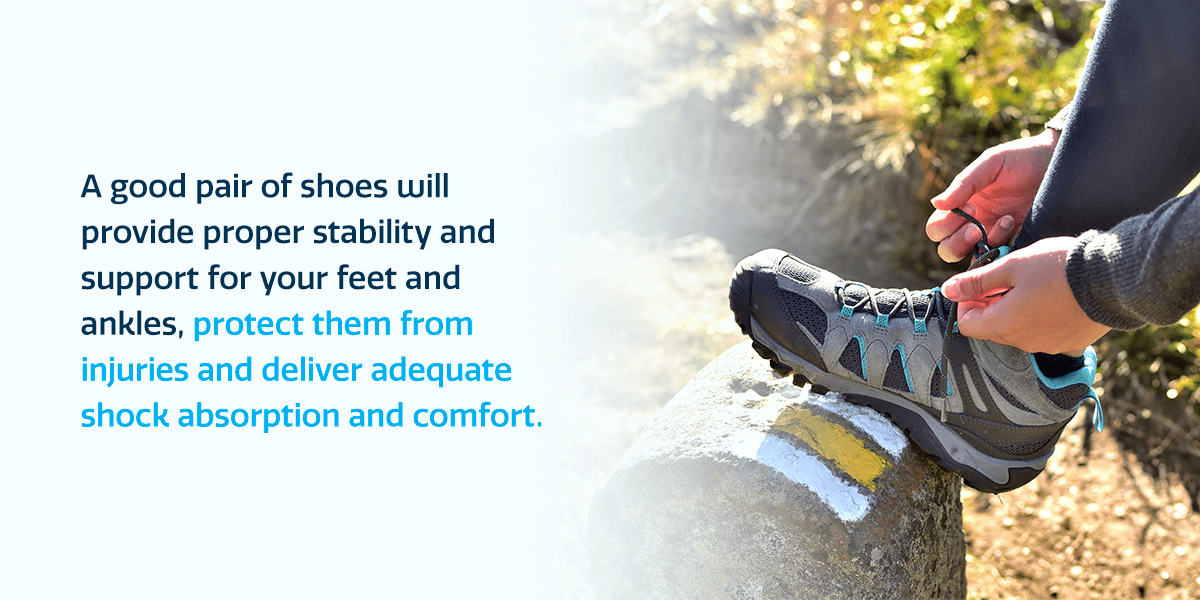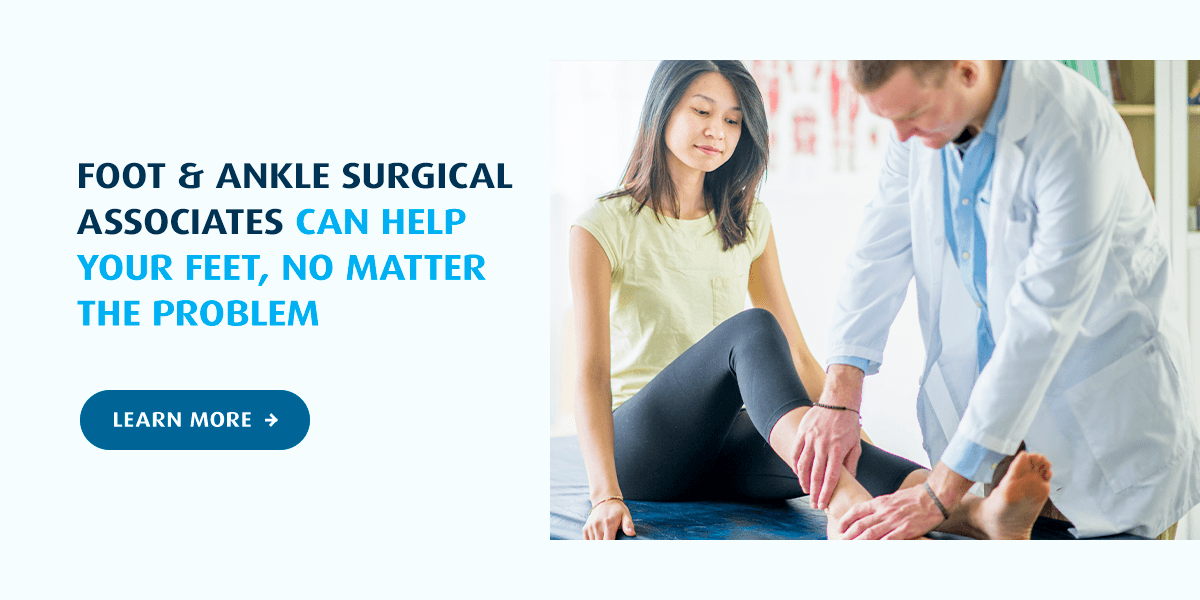With so many fantastic scenic spots in Washington state, you’ll want to protect your feet and ankles so you can enjoy more hikes this season. While almost every hiker will get sore feet or a blister at some point, taking the proper steps to protect your feet before, during and after the hike can prevent more extensive injuries.
Your feet are your most basic means of transportation, and keeping them in the best condition will make your outing more enjoyable. To protect them, follow our feet care tips for hikes:
How to Prepare Feet for a Long Hike
Before you hit the trails, you’ll want to prime your feet and ankles for the excursion. By getting quality gear, lacing your shoes properly and toughening up your feet, you’ll ensure you’re ready for the trek ahead.
1. Use Quality Gear
It’s essential to use quality gear when you’re planning a long hike. Your feet and ankles will thank you later when you invest in something durable and long-lasting. More specifically, a good pair of shoes will provide proper stability and support for your feet and ankles, protect them from injuries and deliver adequate shock absorption and comfort.
When looking for new hiking shoes, search for a pair with the following features:
- Good traction: Your hiking shoes should be slip-resistant to prevent injuries and protect your feet. This is especially important when hiking waterside trails to prevent you from falling or twisting an ankle.
- Breathability: Shoes with adequate ventilation and breathability are essential for the trails. Conventional hiking boots often fail to provide sufficient ventilation, not allowing moisture to escape from the boot. With a breathable shoe, you can protect your feet from rashes, blisters and infections.
- Lightweight: While heavier hiking shoes will last longer, they also result in greater oxygen consumption and energy demands. On the other hand, they can provide more ankle support and stability when carrying a heavy pack. A general rule is to reduce your shoe weight as much as possible without forgoing performance and protection.
- Cushioning: You’ll get proper ankle support on the trails when you invest in shoes with good cushioning. These shoes are also crucial for shock absorption and comfort while hiking on longer routes.
Always try your new pair of shoes in the store before purchasing to ensure they fit your unique foot shape. Pay attention to how the shoe feels on your foot. Your foot shouldn’t slide around, and your toes should not squish together or slide around. Invest in shoes with thick padding around the ankles to prevent blisters and ensure stability.

2. Break in New Shoes
While wearing proper footwear is essential, you’ll want to give yourself adequate time to break in your new shoes before a hike. Without breaking them in, you’ll likely deal with more blisters and have a less enjoyable time on your outing.
Gradually wear them for longer distances and add more weight to your back. You’re likely ready to hit the trails when you can walk over 6 miles without discomfort. If there’s still discomfort, you’ve probably chosen the wrong shoes. Hiking shoes should feel comfortable from the day you get them without requiring too much time to break in.
3. Lace Your Hiking Footwear Properly
Lacing your shoes with the proper techniques can prevent blisters and prepare your ankles for a long hike. Generally, the surgeon’s knot is a great way to lace your shoes before a hike. A surgeon’s knot will keep your toe box loose enough while keeping the shoe tight around your ankle so your feet won’t move around.
If your boots create a pressure point on the top of your foot, the window lacing technique can help alleviate the problem. The toe-relief lacing technique can also alleviate pain in the toes by relieving pressure in the toe box.
4. Strengthen Your Feet
Before each hiking season, take a few weeks to strengthen your feet. That way, you can prepare your feet and ankles for the long hikes and protect them from injuries. Toughening the skin can help reduce blisters, and strengthening the bones, muscles and connective tissue in your feet can prevent stress fractures or soft tissue injuries later on.
A few ways to strengthen your skin and feet include:
- Walk barefoot: Walking barefoot is a simple and natural way to form calluses as you expose your skin to the elements. Start by walking around your house barefoot without socks. Gradually move to the outdoors by starting with pavement, sand or grass before introducing uneven pavement, rocks and gravel. Doing this twice a week can help toughen your feet to reduce blisters and strengthen your ankles for rough terrain.
- Add gradual weight to your back: Your feet will toughen much faster if you prepare by carrying more weight in your backpack. When training for a thru-hike, gradually increase your pack weight each day or week to strengthen your feet and ankles.
- Foot and ankle exercises: Actual exercises like heel raises and towel grabs can strengthen the muscles on the bottom of your feet and improve your range of motion. For an easy ankle exercise before a hike, try sitting on the floor with your right leg straight and the other bent. Wrap a resistance band around your right foot and hold it in both hands. Maintain the resistance while rotating your ankle inward and outward for one rep. Do three sets of 10 repetitions three days a week.

5. Clip Your Toenails
To prepare your feet for a long hike, you must remember to cut your toenails. This is especially important for long-distance treks. Long toenails will push into your shoe and bend, so you’ll want to care for them to prevent them from falling off or causing discomfort.
6. Wear Thin, Antimicrobial Socks
While thick socks might seem a better option for their cushion and protection, you should avoid them and opt for something thin. Thick socks can increase sweating and retain moisture, increasing your risk of blisters.
Even in cold weather, thin socks are the ideal option since you’ll sweat less and prevent moisture from making your feet even colder. Avoid cotton socks, which can retain too much moisture, and opt for socks with a blend of materials like wool or merino, spandex and nylon. Silver yarn can provide incredible antimicrobial features and reduce the bacteria in your socks and the chances of blisters.
Ensure your socks fit well enough to keep your feet from moving around in your shoe and that they have padding around the heel and toe box to help prevent blisters.
How to Care for Feet During a Hike
Now that you’ve taken steps to prepare, follow these tips to care for your feet during a hike:
1. Take Breaks
Care for your ankles during a long hike by taking frequent rest breaks. Depending on your experience level and the hike’s difficulty, physical fatigue can quickly set in, which can easily lead to a misstep or sprain.
Another excellent way to rest your body is by distributing your body weight differently. Using a walking pole can reduce the forces on the joints, including the ankles, thereby minimizing muscle fatigue and the chances of an injury. Additionally, walking poles can offer a support base to keep you in a more stable, upright position.
2. Use Tape When Sores Start
When you get on the trails, tape up your feet as soon as you feel pain or discomfort. Leukotape, sports tape or even duct tape can help prevent blisters from forming so you have a more enjoyable experience. While it might seem frustrating to stop every few minutes to tape your feet at the start of your hike, you’ll have more fun, and your feet will be glad you did it in the long run.
3. Dry Your Socks and Shoes on Breaks
Whenever you stop for a break on the trail, make it a habit to take off your shoes and socks to dry them out. Leaving them in the sun for a while will keep your boots dry and reduce the possibility of blisters forming. Blisters form more easily in wet environments, making this step a must.
If you don’t have enough time to dry your socks, you’ll want to bring a backup pair. As soon as your feet get too hot or wet, change your socks. Tie the wet ones to your backpack so they have time to dry while hiking. This way, you’ll keep your feet dry and comfortable without waiting for your socks to dry in the sun.
4. Elevate Your Legs Between Hikes
Find time during meal breaks or in your tent before sleep to elevate your legs and feet. This can prevent blisters and help you manage foot pain or other injuries while on the trail. Consider hammocks for a comfortable and easy way to keep your feet elevated while resting on multi-day hikes.
5. Remove Grit From Your Shoes
Start with preventive measures to protect your feet and care for your ankles during a long hike. As soon as you feel a pebble, pine needle or any grit in your shoe or sock, remove it immediately. Take care of these items, no matter how big or small. Even the tiniest rocks can wreak havoc on your feet or damage your sock and insole. Light gaiters might also help prevent grit from entering your shoe.
6. Stop if You Feel a Hot Spot
Hot spots are pre-blisters that you can treat while on the trail. As soon as you feel a warm sensation or notice redness in a localized spot on your feet, stop walking immediately and tape the spot with Leukotape or apply a foot balm or powder.
Hot spots can also be caused by rubbing. If you find yourself with wet socks, switch to dry ones to prevent hot spots and feel more comfortable. Do whatever you can to keep the area from rubbing and turning into a blister or open wound.
7. Rinse Your Feet Between Treks
If you’re on a multi-day trip, rinse your feet whenever possible. You’ll keep dirt, grime and dust to a minimum and ensure your feet are protected by taking a break between treks or after a long day of hiking. Only rinse downstream in natural sources and avoid using soap directly in a water source. Use your hands or a bandana to remove stubborn grime.

How to Help Your Feet Recover After a Hike
If you find your ankles or feet sore after a hike, there are a few ways to alleviate the pain.
1. Rest and Elevate Your Feet
You may need a few days off to allow your skin to heal and the muscles in your feet to recover after a long hike. If you’re on a backpacking or thru-hike trip, take a few days to rest either on or off the trail. Try to stay off your feet as much as possible and elevate or ice them to stay cool. If you find your ankles sore after a hike, this will help you keep the pressure off them to relieve pain.
Elevating your legs and feet while laying or sitting down can also improve circulation and reduce swelling while draining excess fluid buildup.
2. Perform First Aid
If you’re taking a break in the middle of a long hike, use this time to perform first aid. Disinfect and dry your blisters and take time to cut your nails if they’re getting too long. If you’ve finished your hike, put on recovery sandals or compression socks to liberate your foot from the grip of your hiking shoes. Custom orthotic devices can also take pressure off uncomfortable spots or ulcerations caused by hiking.
3. Soak Your Feet in Cold Water
If your feet feel swollen or fatigued, soak them in cold water. If you’re still on the trail, only use natural sources to soak your feet — the colder the water, the better. Leave them in for as long as you can. If you don’t have a natural water source, place your full water bags on the tops and bottoms of your feet. If you’ve returned from your hike, fill a bathtub with cold water and put your feet inside to soothe any fatigue.
4. Massage Your Feet
At the end of a long day hiking, make it a habit to massage your feet. Studies show that even a brief massage can reduce foot pain and enhance your comfort. A self-care massage ball can do the trick after a long hike. Massages can also help address discomfort from conditions like plantar fasciitis. You can also prevent stiffness for your next hike by massaging your feet right after a long trip.
Foot & Ankle Surgical Associates Can Help Your Feet, No Matter the Problem
These foot care tips for hikes should help protect them during and after the excursion. But it might be time to see a professional when your feet or ankles are creating significant problems for your functionality. Through physical therapy, orthotics or ankle and foot surgery, you can be back and up on your feet in no time.
Foot & Ankle Surgical Associates professionals are highly trained to treat any foot problems. If you’re experiencing foot or ankle pain, our podiatrists will assess your pain and diagnose the problem to decide on a treatment plan that works for you. We can help you improve your mobility so you can return to the trails and the activities you love as soon as possible.
To schedule an appointment, call us today at 360-754-3338 or fill out a contact form.





